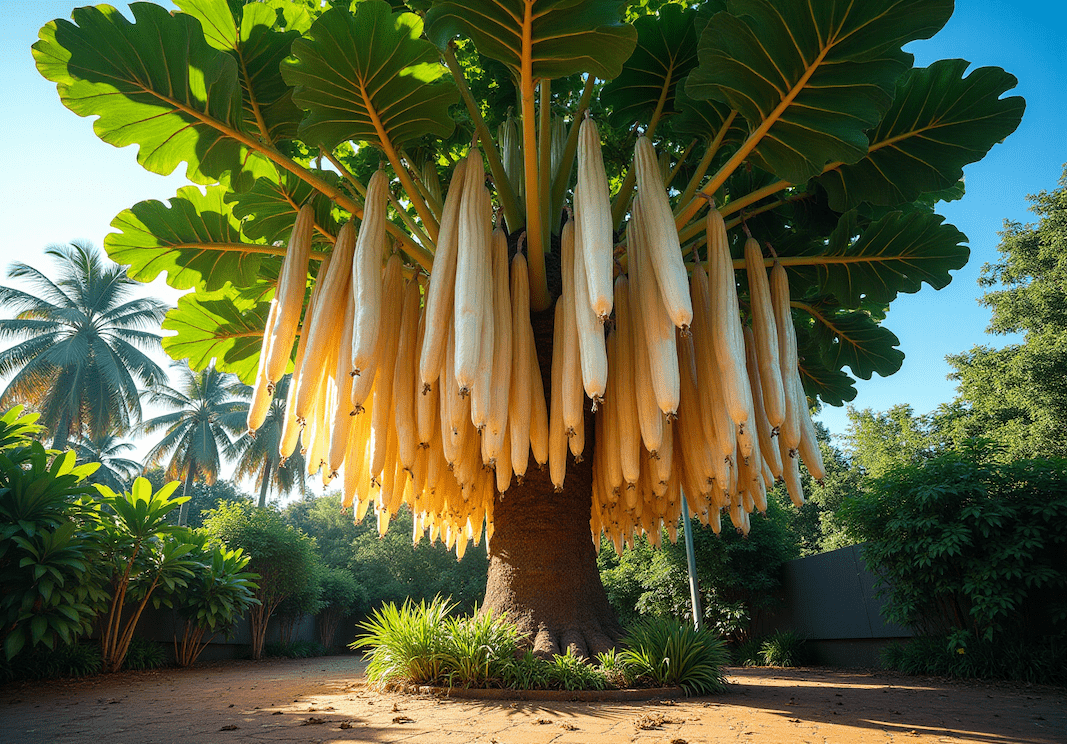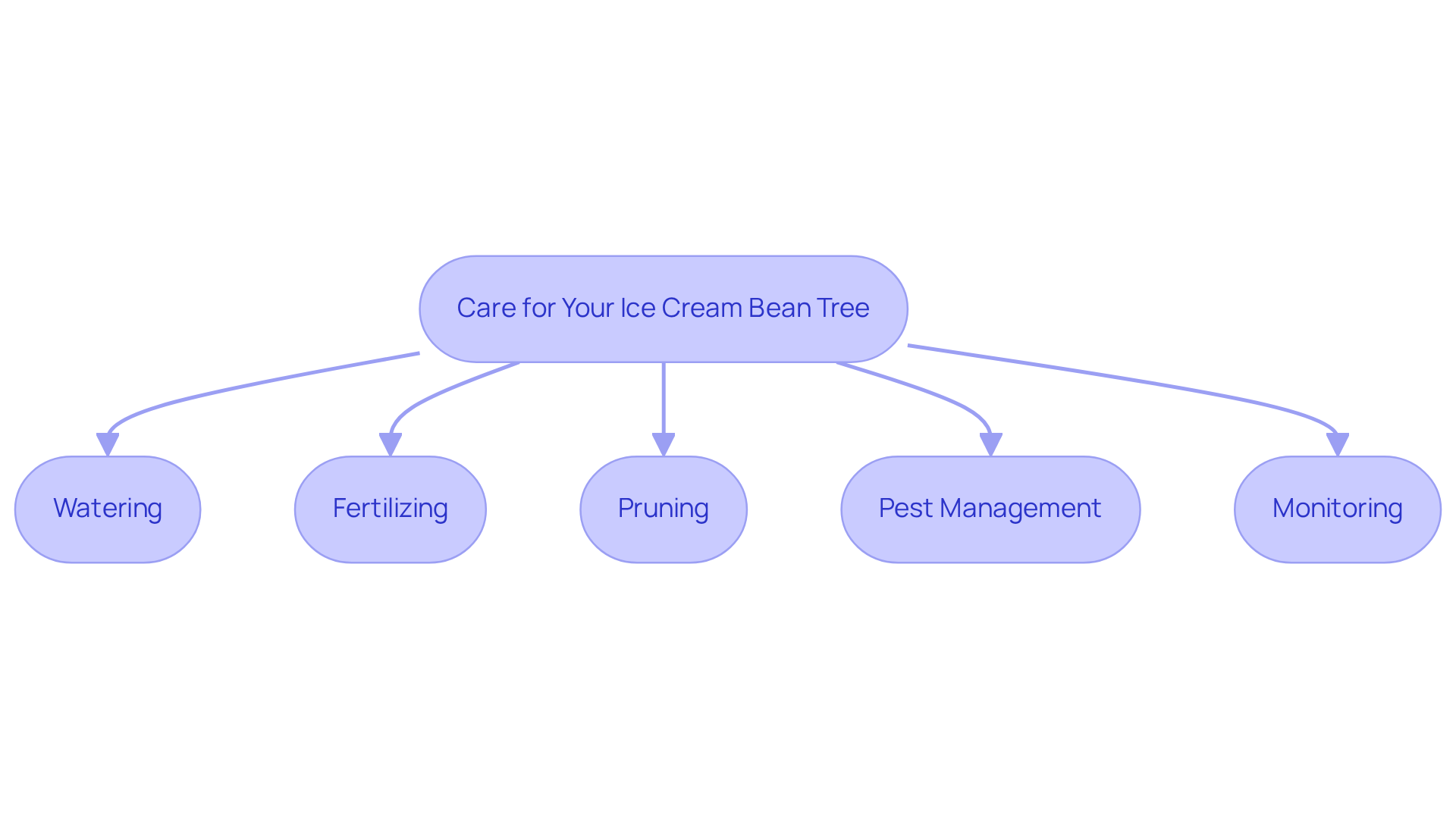
Ice Cream Bean Tree: Planting & Care Tips
Share
The Ice Cream Bean Tree, or Inga edulis, serves as more than just a visually appealing element in tropical gardens; it presents a multitude of benefits that extend beyond its aesthetic charm. This remarkable tree is celebrated for its sweet, fluffy pulp, which closely resembles vanilla ice cream, and it offers significant nutritional value, enriches soil fertility, and bolsters local ecosystems.
However, to successfully cultivate this tropical treasure, it is essential to comprehend its specific planting and care requirements. What are the critical steps necessary to ensure that this unique tree flourishes in a home garden, and how can gardeners effectively address the common challenges it may pose?
Thinking about growing an Ice Cream Bean Tree in your garden?
Explore Ice Cream Bean Tree for sale at Everglades Farm - shipped directly from Florida.
1. Understand the Ice Cream Bean Tree: Characteristics and Benefits
The Ice Bean plant, scientifically known as Inga edulis, is a tropical species native to South America, reaching heights of up to 30 meters. This remarkable ice cream bean tree is characterized by its long, cylindrical pods filled with , reminiscent of vanilla ice cream. Thriving in USDA hardiness zones 9-12, it flourishes in full sun and requires a minimum of 8-10 hours of sunlight daily.
Benefits of the Ice Cream Bean Tree:
- Nutritional Value: The edible pulp is not only delicious but also rich in dietary fiber, protein, and essential vitamins, making it a nutritious addition to any diet. The seeds of Inga edulis contain 339 calories per 100 g, with 18.9 g of protein, further enhancing its nutritional profile.
- Land Enhancement: As a leguminous plant, Inga edulis plays a crucial role in boosting fertility by fixing nitrogen, which benefits surrounding plants.
- Shade Provider: Its expansive canopy provides ample shade, making it an ideal companion for shade-loving crops such as cacao and coffee.
- Erosion Control: The plant's extensive root system stabilizes soil, effectively preventing erosion, particularly on slopes.
- Aesthetic Appeal: With its lush foliage and distinctive pods, the ice cream bean tree adds visual interest and beauty to gardens and landscapes, enhancing their overall charm.
- Traditional Medicinal Uses: Different parts of the Ice Dessert Bean plant have been utilized in traditional medicine to address issues like dysentery and rheumatism, highlighting its holistic advantages.
- Ecological Impact: The Ice Bean plant contributes positively to biodiversity by offering habitat and nourishment for various wildlife species, supporting the ecosystem in tropical gardening.

2. Plant the Ice Cream Bean Tree: Step-by-Step Instructions
To successfully plant your Ice Cream Bean tree, follow these essential steps:
- Choose the Right Location: Select a site that receives full sun exposure for at least 8 hours daily, along with well-draining soil.
- Prepare the Ground: Aim for sandy or loamy soil with a pH range of 5.5 to 7.8. If necessary, enhance the soil with organic matter to boost its fertility.
- Planting: Dig a hole that is twice the width of the root ball and equal in depth. Position the plant in the hole, ensuring that the top of the root ball is level with the ground surface.
- Backfill: Carefully fill the hole with soil, gently compacting it to eliminate any air pockets that could impede root establishment.
- Watering: After planting, thoroughly water the plant to help settle the soil around the roots and .
- Mulching: Apply a layer of mulch around the base of the plant to retain moisture and suppress weed growth, which can compete for essential nutrients.
- Spacing: When planting multiple saplings, ensure they are spaced at least 16 feet apart to accommodate their mature size and encourage healthy growth.
By following these guidelines, you can create an ideal environment for your ice cream bean tree, ensuring its successful establishment and growth.

3. Care for Your Ice Cream Bean Tree: Watering, Fertilizing, and Pruning
To ensure your Ice Cream Bean tree flourishes, follow these essential care guidelines:
- Watering: Regular watering is crucial, especially during dry spells. Aim for approximately 1 inch of water per week, allowing the top inch of soil to dry out between waterings. This practice prevents root rot, ensuring a .
- Fertilizing the ice cream bean tree, which is a nitrogen-fixing species, typically requires minimal fertilization. However, applying a balanced organic fertilizer once a year in spring can enhance growth. This approach supports the plant's nutrient needs while mitigating the risk of over-fertilization.
- Pruning your Ice Cream Bean tree should be done in late winter or early spring to remove any dead or damaged branches and to shape the plant. This not only improves air circulation and light penetration but also promotes healthier growth overall.
- Pest Management: Regularly inspect the plant for pests such as mealybugs and aphids. If any are found, applying neem oil or insecticidal soap can effectively control these pests without harming the plant.
- Monitoring: Vigilantly observe the plant for signs of stress, such as yellowing leaves or wilting. These symptoms may indicate overwatering or nutrient deficiencies. Addressing these issues promptly will help maintain the plant's health and vitality.

4. Troubleshoot Common Issues: Pests, Diseases, and Growth Problems
Common issues with Ice Cream Bean trees include:
- Pests: Be vigilant for aphids, mealybugs, and spider mites. Effective treatments, such as neem oil or insecticidal soap, can help manage infestations, ensuring the health of your plant.
- Diseases: Although the plant is generally resistant to diseases, it can be susceptible to root rot in overly wet conditions. Ensuring proper drainage is crucial to prevent this issue. Notably, Inga edulis has shown resilience against many diseases, making it a reliable choice for gardeners.
- Growth Issues: If your plant shows restricted growth, evaluate environmental elements like insufficient sunlight or inadequate drainage, which can impede development. The ice cream bean tree thrives in well-draining sandy or loamy soil and prefers a temperature range of 69-82°F (20-28°C).
- Leaf Issues: Yellowing leaves may signal , while brown tips could indicate underwatering or exposure to high temperatures. Adjust your watering schedule to maintain optimal moisture levels for healthy foliage.
- Fruiting Problems: If the plant fails to produce fruit, verify that it receives ample sunlight and nutrients. Pruning may also be beneficial to enhance air circulation and promote fruiting. Additionally, the nitrogen-fixing ability of ice cream bean trees supports overall plant health.

Conclusion
The Ice Cream Bean tree, or Inga edulis, is a remarkable addition to any garden, offering unique aesthetic appeal alongside a multitude of benefits. This tropical species thrives in sunny environments, enriching the soil while providing nutritious, edible pods that resemble vanilla ice cream. Its ability to enhance biodiversity and support local ecosystems makes the Ice Cream Bean tree an invaluable asset for both gardeners and nature enthusiasts.
In this article, essential steps for planting and caring for the Ice Cream Bean tree have been outlined. These include:
- Selecting the right location
- Preparing the soil
- Implementing a consistent watering and fertilization routine
Moreover, the importance of monitoring for pests and diseases, as well as addressing common growth issues, has been emphasized to ensure the tree's health and vitality. By following these guidelines, gardeners can create an optimal environment for their Ice Cream Bean trees, promoting successful growth and fruit production.
Incorporating the Ice Cream Bean tree into a garden not only enhances its beauty but also contributes positively to the surrounding ecosystem. As awareness of sustainable gardening practices grows, planting this unique tree serves as a step toward fostering biodiversity and improving soil health. Embrace the opportunity to cultivate an Ice Cream Bean tree and enjoy its many benefits, from delicious pods to ecological contributions, thereby making a meaningful impact on your gardening journey.
Transform Your Garden with the Ice Cream Bean Tree!
Start your journey towards a vibrant, sustainable garden today—order now and enjoy the beauty and benefits of this tropical gem.
Frequently Asked Questions
What is the Ice Cream Bean Tree and where is it native to?
The Ice Cream Bean Tree, scientifically known as Inga edulis, is a tropical species native to South America.
How tall can the Ice Cream Bean Tree grow?
The Ice Cream Bean Tree can reach heights of up to 30 meters.
What are the characteristics of the Ice Cream Bean Tree?
The tree is characterized by its long, cylindrical pods filled with sweet, fluffy pulp that resembles vanilla ice cream.
In which USDA hardiness zones does the Ice Cream Bean Tree thrive?
The Ice Cream Bean Tree thrives in USDA hardiness zones 9-12.
How much sunlight does the Ice Cream Bean Tree require?
It requires a minimum of 8-10 hours of sunlight daily.
What nutritional benefits does the pulp of the Ice Cream Bean Tree offer?
The edible pulp is rich in dietary fiber, protein, and essential vitamins, making it a nutritious addition to any diet.
What is the caloric and protein content of the seeds of Inga edulis?
The seeds contain 339 calories per 100 grams and 18.9 grams of protein.
How does the Ice Cream Bean Tree enhance land fertility?
As a leguminous plant, it fixes nitrogen in the soil, which benefits surrounding plants.
What role does the Ice Cream Bean Tree play in providing shade?
Its expansive canopy provides ample shade, making it suitable for shade-loving crops like cacao and coffee.
How does the Ice Cream Bean Tree help with erosion control?
The plant's extensive root system stabilizes soil, effectively preventing erosion, especially on slopes.
What aesthetic benefits does the Ice Cream Bean Tree provide?
With its lush foliage and distinctive pods, it adds visual interest and beauty to gardens and landscapes.
What traditional medicinal uses are associated with the Ice Cream Bean Tree?
Different parts of the plant have been used in traditional medicine to address issues like dysentery and rheumatism.
What ecological benefits does the Ice Cream Bean Tree offer?
It contributes positively to biodiversity by providing habitat and nourishment for various wildlife species, supporting the ecosystem in tropical gardening.


